On the muddy River Thames, London has more famous sights, culture, entertainment and historical curiosities than you could experience in years, let alone one trip.
But we can boil down the capital to 25 essential things to do, and on the way get to know statesmen, royalty and scientists who changed the course of history.
The Thames becomes an estuary just east of London, and was the launch pad for the UK’s dominion of the seas in the 18th and 19th centuries.
It’s easy to get stuck talking about London’s past, but what’s exciting about this city is the way it safeguards its historical wealth while always being open to the new and different.
1. British Museum
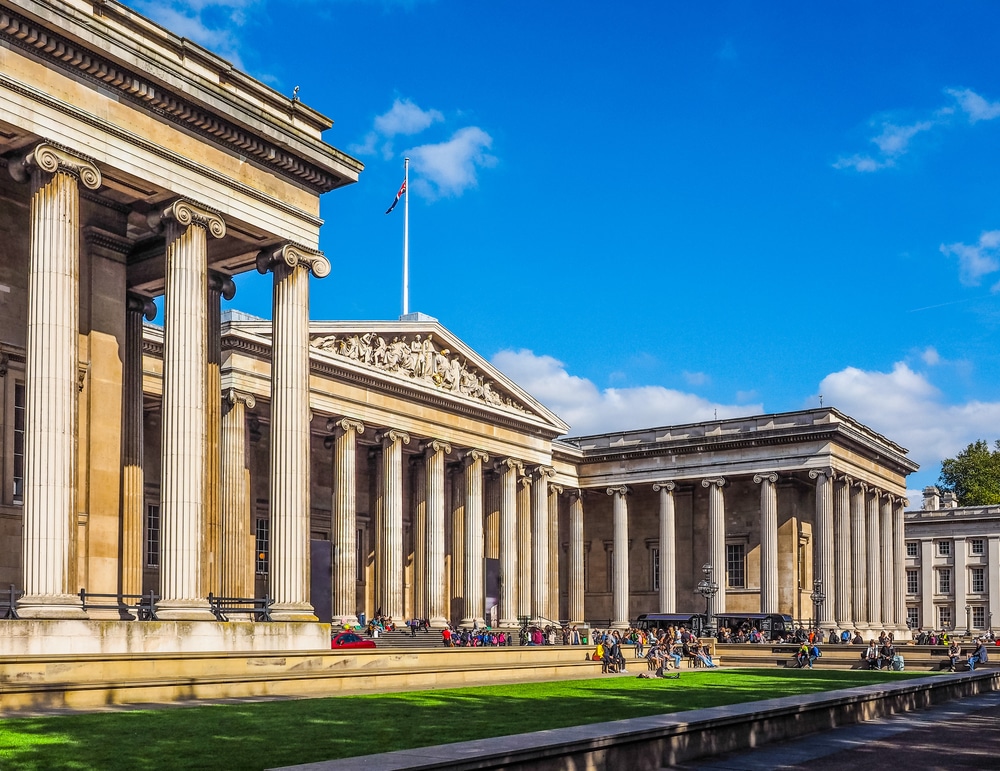 Source: Claudio Divizia / shutterstock
Source: Claudio Divizia / shutterstockThe world’s first public national museum opened in 1753 and has built up a vast collection of more than eight million objects across thousands of years of human civilisation.
The current building, with its famous Ionic portico, was ready in 1857 and was given an update for the new Millennium with a glass roof designed by Norman Foster covering the Great Court.
Now, as a product of colonisation and the British Empire the museum is not without controversy, especially in the way that priceless objects like the Elgin marbles from the Parthenon and Acropolis were obtained.
Still, for anyone with even a passing interest in history there are few places in the world where you can view this many culturally significant objects in the space of an hour or two.
Most crucial of all is surely the Rosetta Stone (2nd century BCE), closely followed by the likes of the stunning Sophilos Vase (7th century BCE), naturalistic Medieval heads from Ife, the 12th-century Lewis Chessmen, the 14th-century Sloane astrolabe and the huge Younger Memnon, from the 13 century BCE and weighing 7.5 tons.
Website: https://www.britishmuseum.org/
2. St Paul’s Cathedral
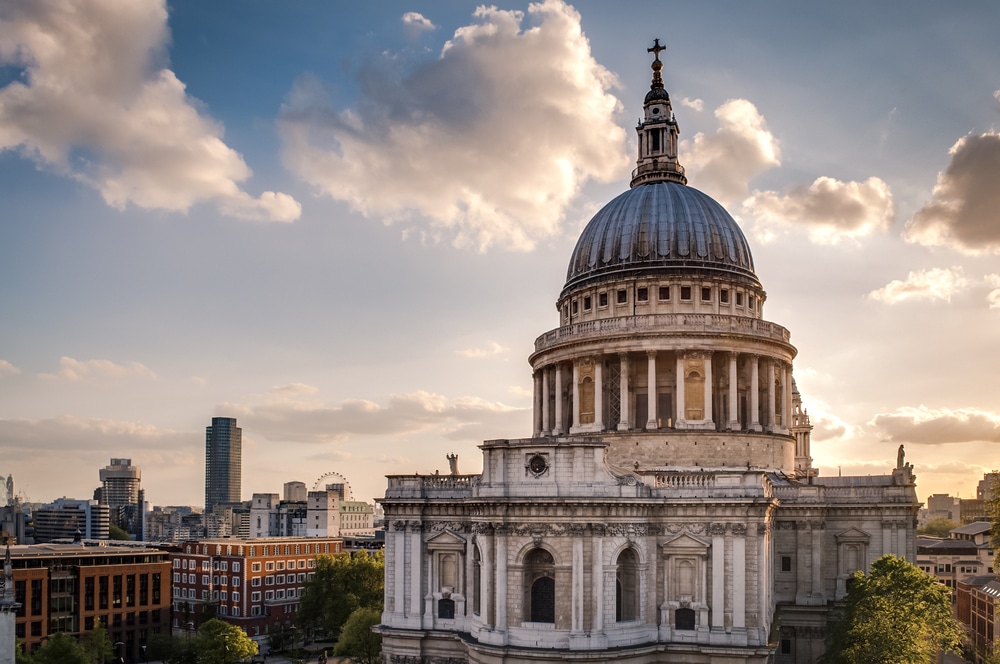 Source: Victor Moussa / shutterstock
Source: Victor Moussa / shutterstockOne of those sights that springs to mind when you think of London, St Paul’s Cathedral is the masterpiece of the English Baroque, with the second largest area of any church in the UK and one of the highest domes in the world.
Designed by Christopher Wren and placed on the highest point of the City of London, the church dates to the last decades of the 17th century and is the centrepiece for the reconstruction of the capital after the Great Fire of London in 1666.
This monument has witnessed scores of historic events, from the funerals for Winston Churchill and Admiral Horatio Nelson to the wedding of Charles and Diana in 1981.
The Old Medieval St Paul’s Cathedral also had an epic scale and replaced another cathedral that burnt down in the 11th century.
Visit to take in St Paul’s sublime but understated decoration and astounding proportions, which become especially apparent as you scale the building and look down on the crossing from the Whispering Gallery, 259 steps up from the church floor in the base of the dome.
As the name tells you, the acoustics at this gallery are sensational, and you can continue to the Golden Gallery at the top of the dome, for a total of 528 steps.
Down in the crypt, the largest in Europe, are tombs and memorials for dozens of important figures, including Wren himself.
Website: https://www.stpauls.co.uk/
3. Victoria and Albert Museum (V&A)
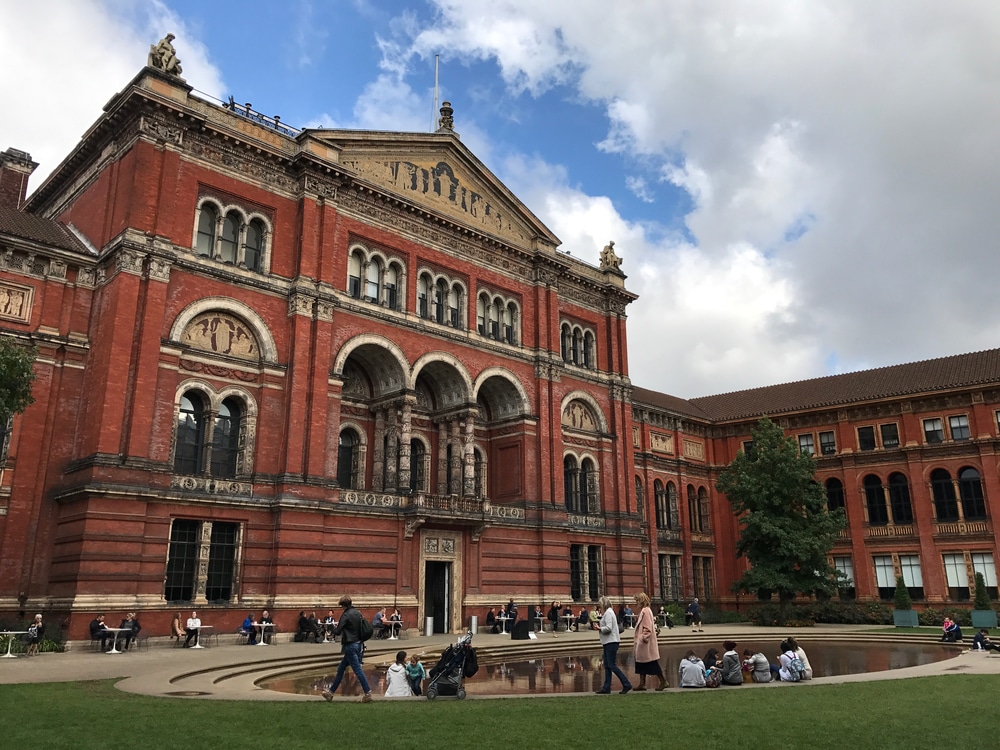 Source: Can Ogan / shutterstock
Source: Can Ogan / shutterstockThe pick of the world-class attractions in South Kensington is billed as the world’s leading museum dedicated to art and design.
Set up in 1852 and named for Queen Victoria and Prince Albert, the V&A has more than 140 galleries teeming with pieces from across the world, spanning 5,000 years.
The holdings are impossibly rich, and represent a journey through the history of human creativity, from ancient Chinese ceramics to film costumes worn by the likes of Fred Astaire.
To try to sum up, there’s exquisite and historically significant jewellery, wallpaper, furniture, fashion, photography, musical instruments, metalwork, ceramics, manuscripts, architecture, books and painting.
The V&A also holds the world’s largest collection of post-classical sculpture, and the largest array of Italian Renaissance sculpture outside Italy.
As well as getting lost in the permanent exhibition, you have to book a slot for one of the many temporary exhibitions (more than 12 a year).
Recent shows have dealt with Frida Kahlo, costume from the history of Hollywood and a record-breaking exhibition for designer Alexander McQueen.
Website: https://www.vam.ac.uk/
4. Tower of London
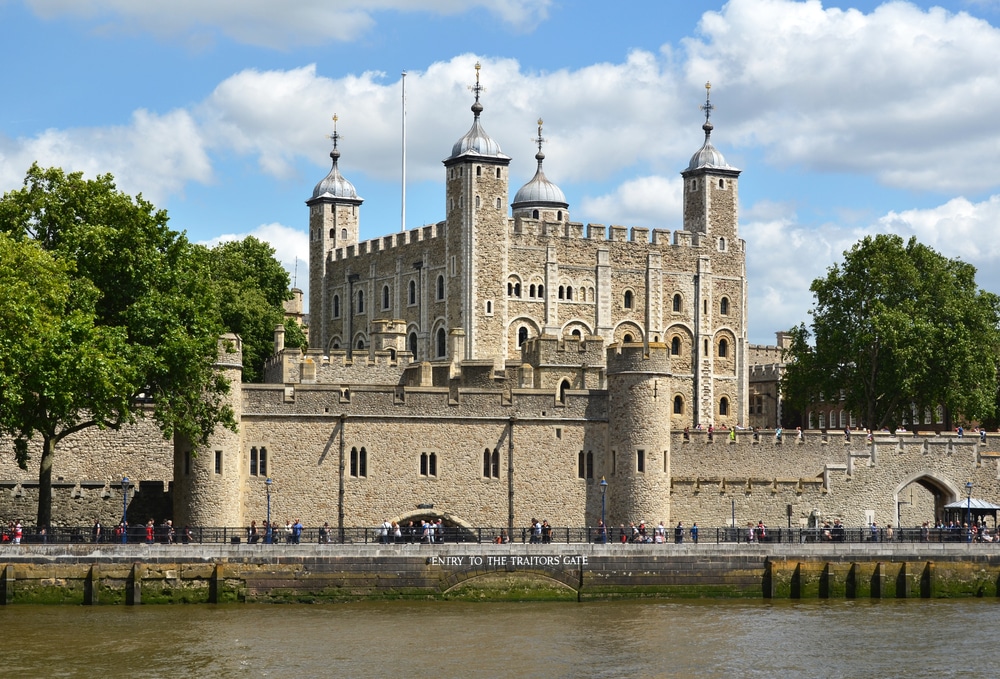 Source: Alexander Chaikin / shutterstock
Source: Alexander Chaikin / shutterstockAfter William I conquered England he set about consolidating his new kingdom with a forbidding castle known as the White Tower.
Still watched by Beefeaters, ceremonial guardians in Tudor uniforms, this keep is at the core of a Medieval fortress expanded several times in up to the 16th century.
A UNESCO World Heritage Site, the Tower of London is the best example of an 11th-century fortress-palace in Europe, and is naturally steeped in history, not least as a royal residence until Tudor times.
Numerous British institutions had their origins at the Tower of London, which in its time has served as the home of the Royal Mint, as well as an armoury, treasury and public record office.
Guy Fawkes was tortured here in 1605 after the failed Gunpowder Plot, while the queens Anne Boleyn (1536), Catherine Howard (1542) and Lady Jane Grey (1554) are just three of the famous figures executed at the Tower.
Among other things you’ll learn the bloody 15th-century history of the Princes in the Tower, meet the resident ravens, visit the Romanesque St John’s Chapel and marvel at the Crown Jewels, kept here since the 17th century.
5. Westminster Abbey
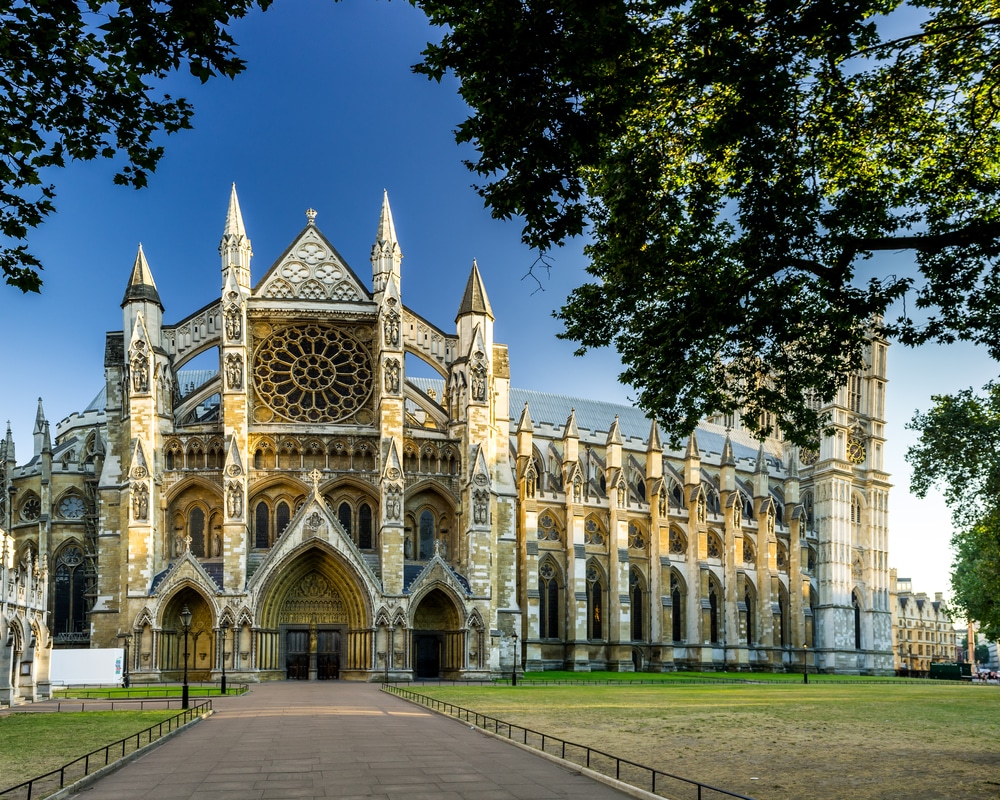 Source: Grzegorz_Pakula / shutterstock
Source: Grzegorz_Pakula / shutterstockUp there with St Paul’s among the UK’s most famous places of worship is this “Royal Peculiar” church, formerly attached to a Benedictine monastery dissolved under Henry VIII in 1539.
Every coronation of a British monarch since William the Conqueror in 1066 has taken place at Westminster Abbey.
The building appears in the Bayeux Tapestry, and that 11th-century Romanesque building was redeveloped in the current, spectacular Gothic style beginning in the middle of the 13th century.
Westminster Abbey is suffused with Medieval splendour, holds the burials and memorials for countless pivotal historical figures, and has set the scene for momentous historical events.
It’s hard not to be overwhelmed, but a few of the must-sees are the Royal Tombs at the east end, the Coronation Chair, ordered for Edward I in the 13th century, the beautiful cloisters, the Pyx Chamber, which dates to 1070, Britain’s Oldest Door (1032) and Poet’s Corner in the South Transept.
At the latter you’ll find tombs and memorials for world-famous poets and writers, from Jane Austen and the Bronte Sisters to Shakespeare and Dickens.
Website: https://www.westminster-abbey.org/
6. National Gallery
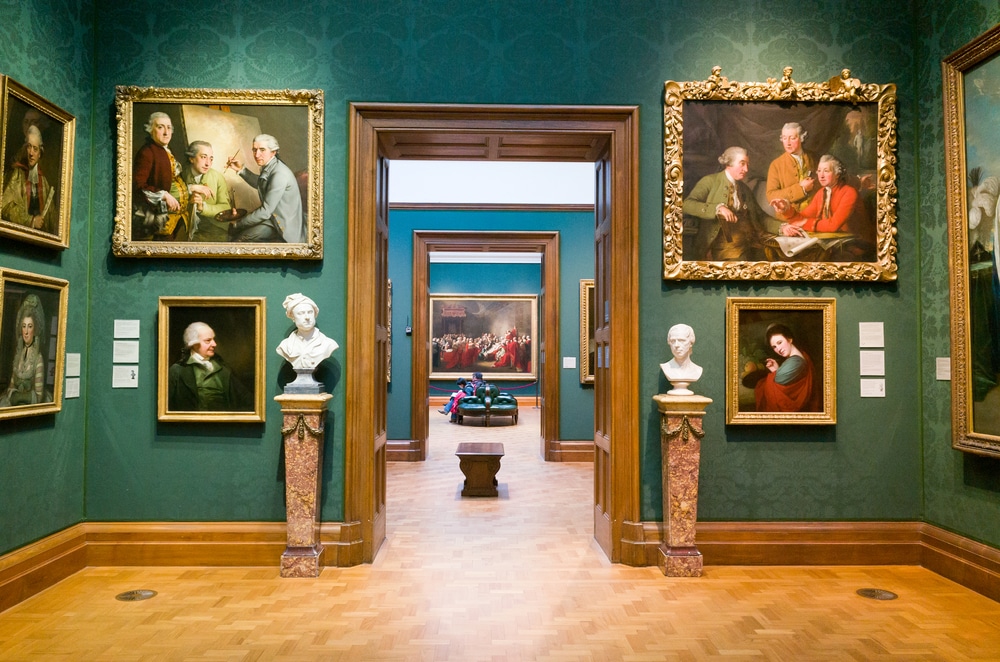 Source: Alex Segre / shutterstock
Source: Alex Segre / shutterstockThe UK’s staggering collection of fine art, dating from the mid-1200s to 1900 is housed in the imposing Neoclassical building that forms the northern backdrop to Trafalgar Square.
Displayed according to period, the National Gallery has one of the richest catalogues in the world, littered with epochal works by Hans Holbein the Younger, Hieronymus Bosch, Vermeer, van Eyck, Botticelli, Titian, Tintoretto, Leonardo da Vinci, Rembrandt, Rubens, Diego Velázquez, Delacroix, Monet and van Gogh, just by way of introduction.
The temporary exhibitions are always worthwhile, and have dealt with Titian, Gauguin, Mantegna & Bellini in the last few years.
The National Portrait Gallery adjoins this building on St Martin’s Place, and among its many important works are the Chandos portrait of William Shakespeare and self-portraits by famous British artists like Gainsborough and Reynolds.
Website: https://www.nationalgallery.co.uk/
7. Tate Modern
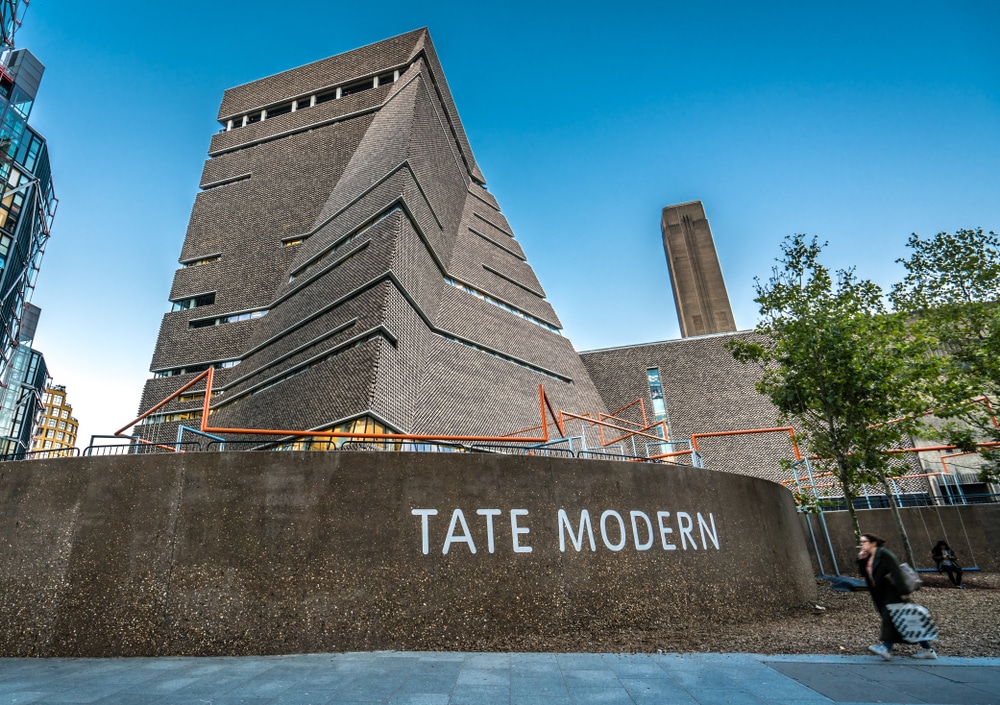 Source: NoyanYalcin / shutterstock
Source: NoyanYalcin / shutterstockIn the year 2000, the national collection for British art dating from 1900 to the present was given a sensational new venue at the converted Bankside Power Station.
This structure was built between 1947 and 1963 to a design by Giles Gilbert Scott, also known for the UK’s iconic red telephone box.
The Tate Modern makes the most of the building’s immense scale, and the Turbine Hall for instance has become a space for large temporary installations by the likes of Olafur Eliasson.
In the permanent collection are works by luminaries of modern and contemporary art, among them Picasso, Delaunay, Kirchner, Monet, Georges Braque, Paul Klee, Juan Gris, Tracey Emin, Yinka Shonibare and Chris Ofili.
The Tate Modern stages several major exhibitions each year, recently featuring Warhol, Eliasson, Zanele Muholi, Joan Jonas and Picasso.
In 2016 the gallery doubled its exhibition space with the opening of three underground circular oil tanks previously used by the power station, and the 65-metre Switch House extension, standing above those tanks.
Website: https://www.tate.org.uk/visit/tate-modern
8. Greenwich
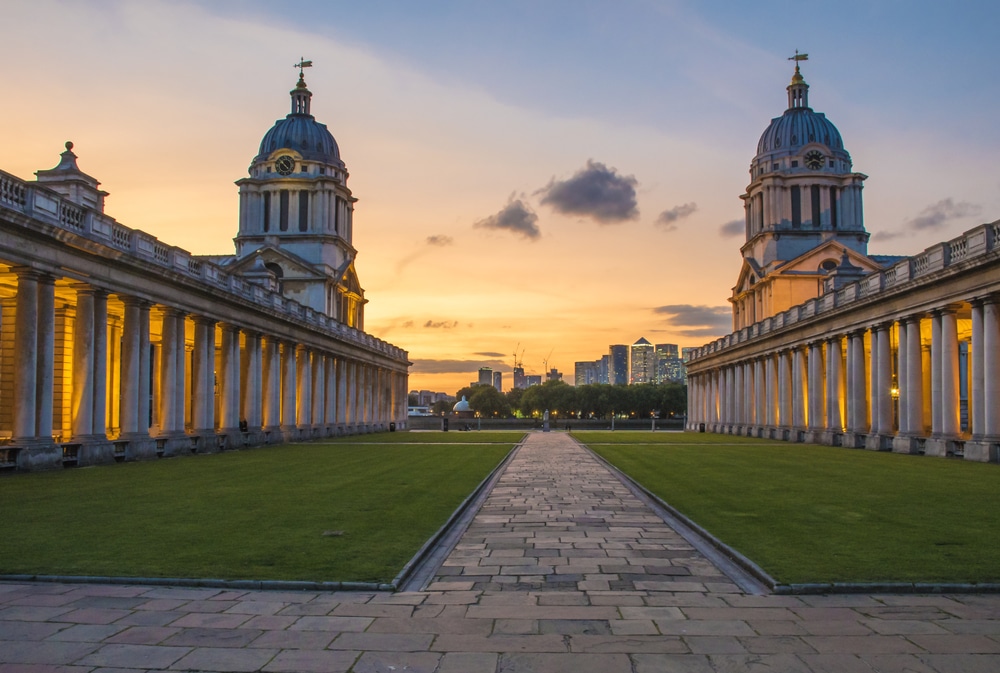 Source: Bildagentur Zoonar GmbH / shutterstock
Source: Bildagentur Zoonar GmbH / shutterstockTo visit Greenwich, on the river in Southeast London, is to discover the navigational prowess that built an empire.
Maritime Greenwich is a UNESCO World Heritage Site, at the heart of which is a symmetrical Baroque complex designed by Sir Christopher Wren as the Royal Hospital for Seamen.
This was built at the turn of the 18th century on the site of a former royal palace and complementing the Queen’s House (1635), England’s first Palladian palace, designed by Inigo Jones.
Make sure to see the Painted Hall, with sumptuous late-Baroque murals depicting, among other things, William III and Mary II’s accession, and dating from 1707 to 1726.
Up the hill in the park that was initially laid out by André Le Nôtre, of Versailles fame, is the Royal Observatory (1676), which laid the scientific groundwork for England and then the UK’s seaborne hegemony in the 18th and 19th centuries.
The Maritime Museum, the preserved Cutty Sark clipper (1869),the riverside, the covered market and the splendid and historic Greenwich Park are just a few of many other things to get up to.
Also, at the tip of the North Greenwich peninsula is the events, entertainment and dining venue, the O2, converted from the Millennium Dome, a year-long exhibition completed in 2000.
9. Palace of Westminster
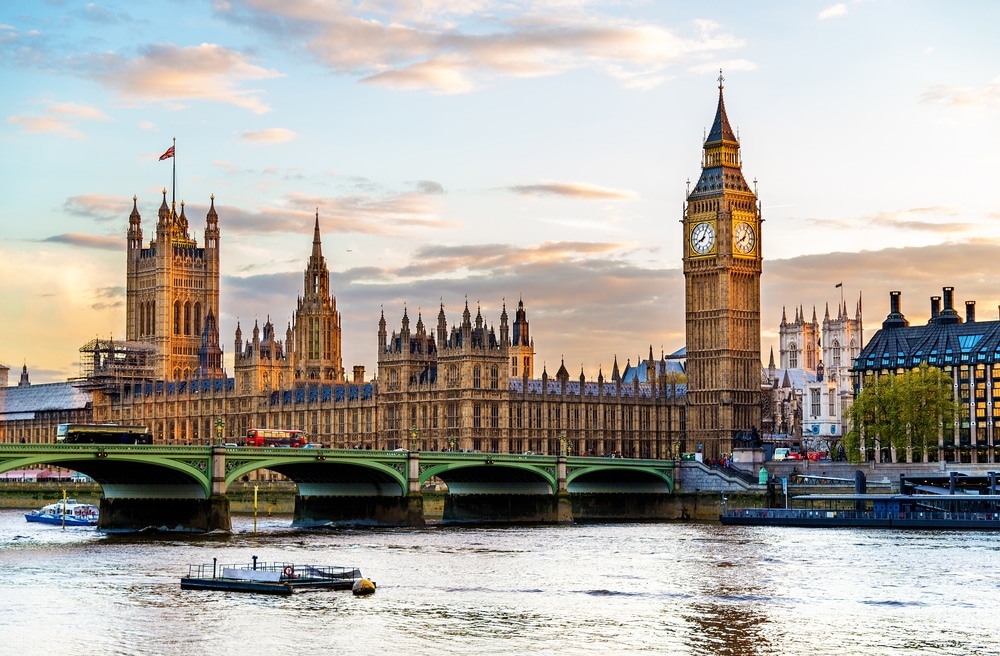 Source: Leonid Andronov / shutterstock
Source: Leonid Andronov / shutterstockPossibly the most emblematic and most culturally significant landmark on this list is the riverside Gothic Revival complex holding the two houses of the Parliament of the United Kingdom, the House of Commons and the House of Lords.
After their previous home, the Medieval Old Palace, was burnt down in 1834, this magnificent replacement, with extremely intricate stonework, was built between 1840 and 1876, to designs by Charles Barry and Augustus Pugin.
The most recognisable element has to be the 96-metre Elizabeth Tower, housing the bell, Big Ben, which strikes the hours.
The broader Victoria Tower, centrepiece of Monet’s famous depictions of the Palace, flies the Union Jack when Parliament is sitting.
Although the Palace of Westminster isn’t billed as a visitor attraction, you can go and watch a debate from the galleries, or take a guided tour to get a handle on the complex’s inner workings.
Website: https://www.parliament.uk/visiting/
10. Buckingham Palace
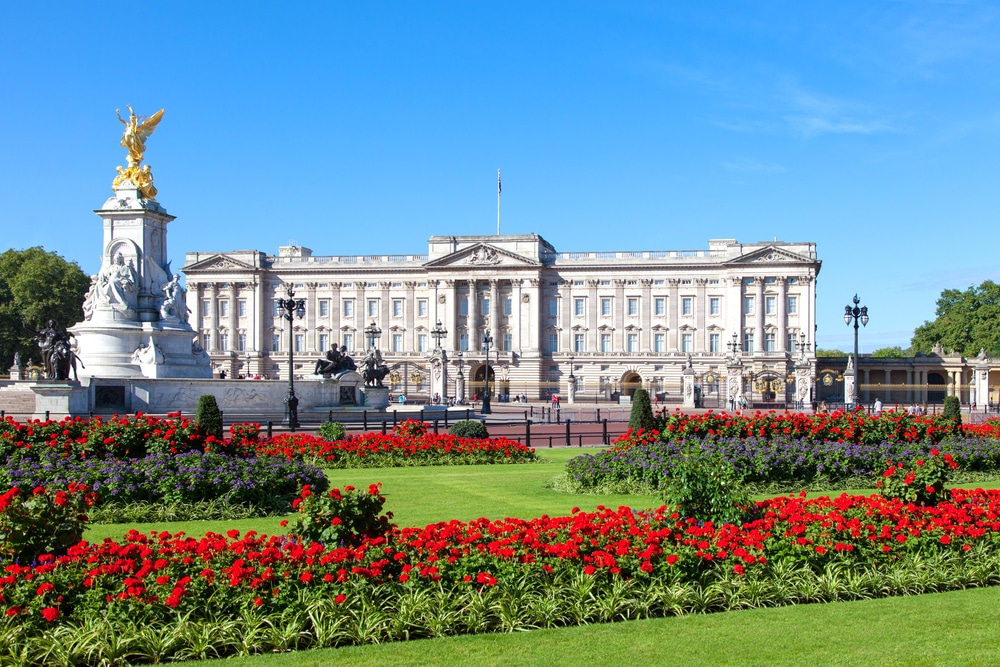 Source: Ewelina Wachala / shutterstock
Source: Ewelina Wachala / shutterstockThe anchor for the UK’s constitutional monarchy is Buckingham Palace, surrounded by Royal Parks at the conclusion of The Mall, leading from Trafalgar Square via Admiralty Arch.
Since 1837 this has been the official headquarters of the King or Queen, with 775 rooms, a main facade more than 100 metres long and the largest private garden in London.
The palace dates back to a Baroque residence constructed for the Duke of Buckingham in 1703, while the stately Neoclassical facade dates from an early-19th century enlargement by John Nash and Edward Blore.
Buckingham Palace is fixed in the nation’s consciousness, and still a point of reference during national celebrations or mourning.
In the forecourt you can watch the Changing the Queen’s Guard, taking place at 11:00 every day in summer, and four times a week in other seasons.
You can visit the palace during brief windows in summer, but also December, January and Easter, to tour the sumptuous State Rooms, among them the Throne Room, White Drawing Room and Ballroom, all rich with precious items that have their own story to tell.
Website: https://www.royal.uk/royal-residences-buckingham-palace
11. Trafalgar Square
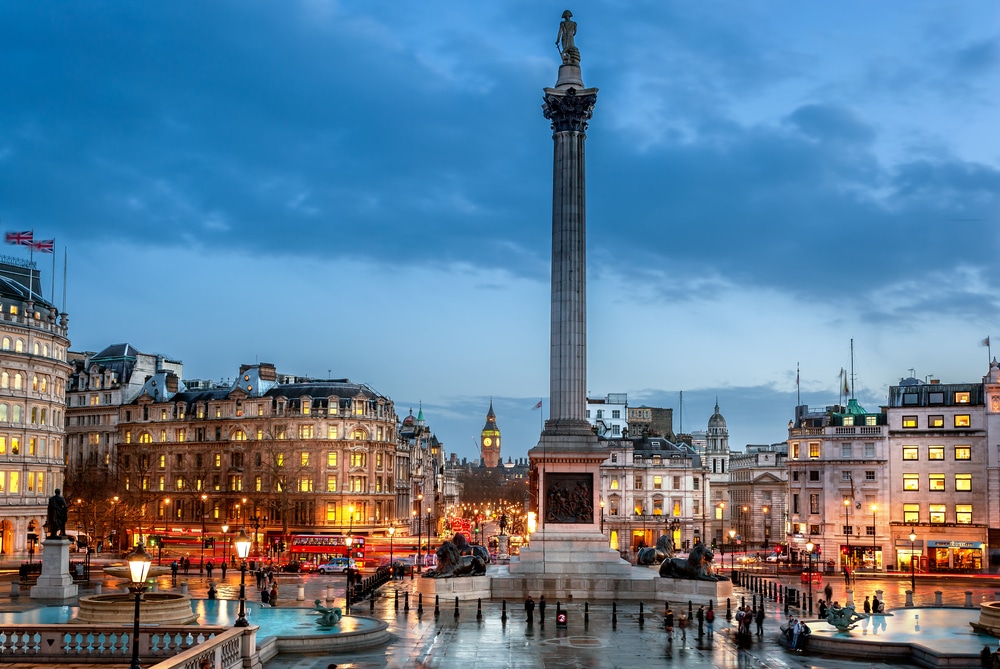 Source: SAKhanPhotography / shutterstock
Source: SAKhanPhotography / shutterstockLaid out to celebrate the British victory at the Battle of Trafalgar (1805), this impressive plaza by Charing Cross was decades in the making and wouldn’t be completed until the 1840s.
Trafalgar Square is another of those sights that immediately comes to mind when you think of London, not least for Nelson’s Column.
This commemorates Admiral Horatio Nelson (1758-1805), who masterminded the victory and was famously killed in the battle. His statue stands atop a fluted Corinthian column, rising from a pedestal with bronze reliefs depicting Nelson’s victories and death (facing Whitehall).
The monumental bronze lions guarding the base are the work of Edwin Lanseer and weren’t added until 1867.
The plaza’s two fountains are even more recent, and were created in the 1930s by Edwin Lutyens to counter the reflective heat caused by what was then an asphalt surface.
Like Parliament Square at the other end of Whitehall, Trafalgar Square has always been a gathering place for political demonstrations, but also hosts all manner of public events throughout the year, and every Christmas has a Norway spruce presented by Oslo.
12. Science Museum
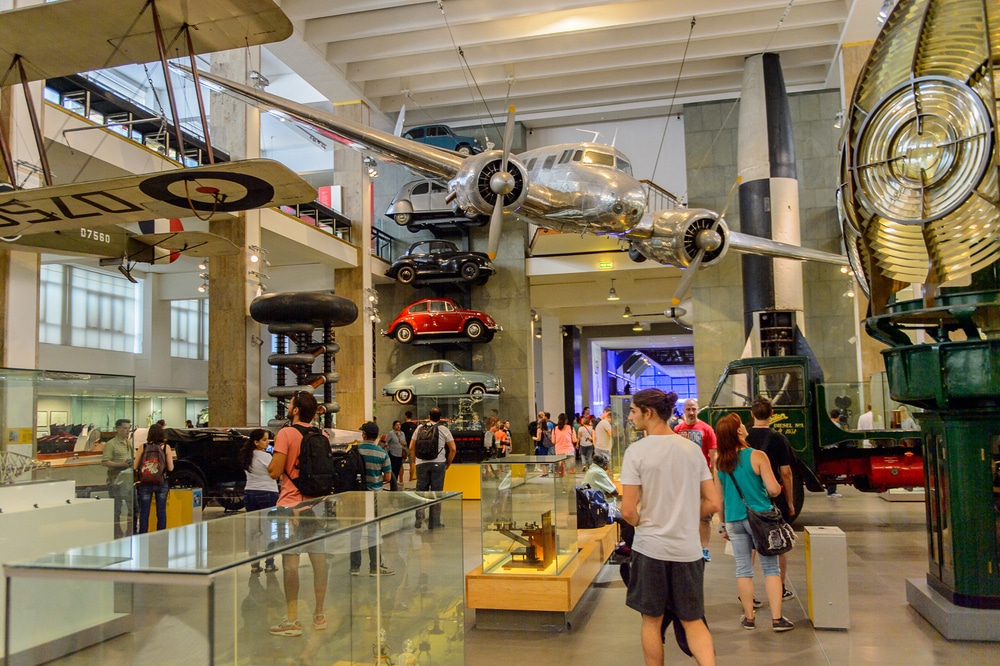 Source: Anton_Ivanov / shutterstock
Source: Anton_Ivanov / shutterstockFounded in 1857, the Science Museum was combined with the V&A for its first few decades and became a separate entity in 1909.
Now it’s among the most visited museums of its kind in the world, where you can indulge your interest in countless fields, from medicine to flight, space exploration, the Industrial Age, the Information Age and much more.
Part of the wonder of the Science Museum is seeing game-changing inventions and discoveries with your own eyes.
There’s the world’s first jet engine, the world’s oldest surviving steam locomotive, a working example of Charles Babbage’s Difference Engine and James Watt’s workshop.
And being a modern museum, there’s a world of interactivity to help people of all ages tackle complicated scientific concepts. Added to all that is an IMAX 3D Cinema for eye-popping presentations.
Website: https://www.sciencemuseum.org.uk/
13. Hyde Park
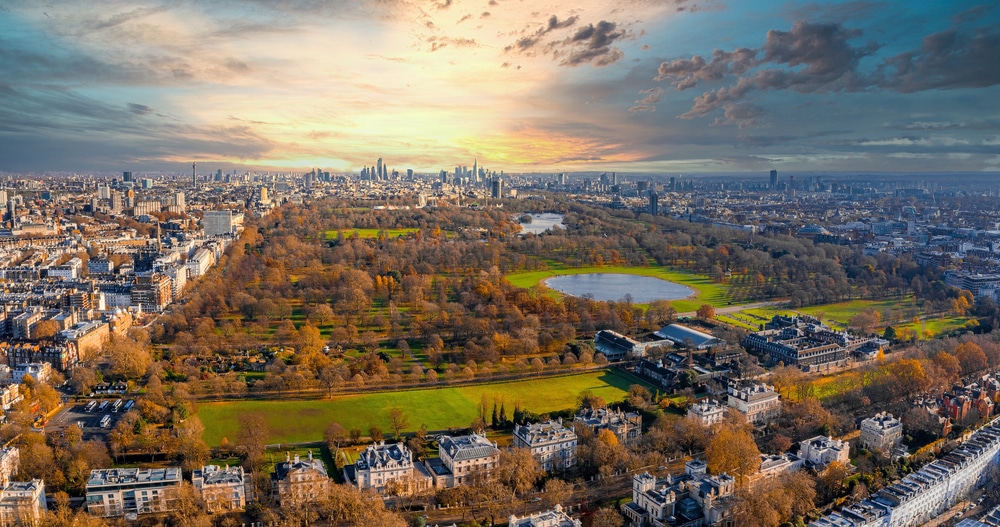 Source: Ingus Kruklitis / shutterstock
Source: Ingus Kruklitis / shutterstockWest of the posh Park Lane, a big tranche of central London is occupied by one of the world’s great city parks, open to the public for more than 400 years.
Before that, Hyde Park was taken from Westminster Abbey by Henry VIII, who used it as a hunting ground from 1536.
There’s much to get up to in these 350 acres, from picnics to boating on the Serpentine, cycling, catching a speech at Speakers’ Corner, admiring public art by the likes of Henry Moore and even horse riding along the carriage drives.
Flanking the lake are the Serpentine Galleries, hosting free, high-profile temporary art exhibitions, with a temporary pavilion every summer designed by one of the world’s leading architects.
The colder months in Hyde Park mean Winter Wonderland, bringing a skating rink, fairground rides, amusements, snacks, ice sculptures, mulled wine, a circus and much more.
14. Royal Botanic Gardens, Kew
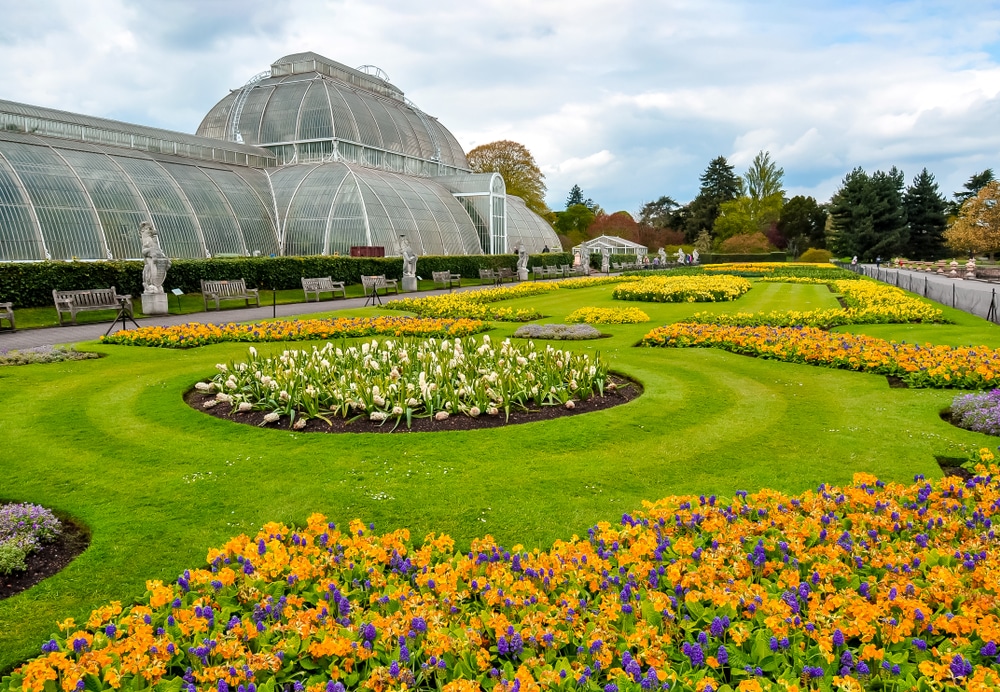 Source: Mistervlad / shutterstock
Source: Mistervlad / shutterstockThis sprawling, UNESCO-listed botanic garden is on a patch of Thames-side land inhabited by royalty on and off going back to the 14th century.
As well as presenting 50,000 living plants and sublime historic and modern conservatories, Kew Gardens is littered with beautiful old monuments.
Among them are the Georgian Great Pagoda (1762), Kew Palace (1631) home to George III for a time, and a quaint thatched cottage built by George for his wife Queen Charlotte around 1771.
With more than 14,000 trees in some 300 acres it can take a long time to cover the gardens.
There are lots of memorable experiences to divert you on the way, like the 200-metre Treetop Walkway, 18 metres over the ground, a museum, two galleries and the fabulous Temperate House (1859), the world’s largest surviving Victorian glass structure.
Website: https://www.kew.org/
15. Regent’s Park
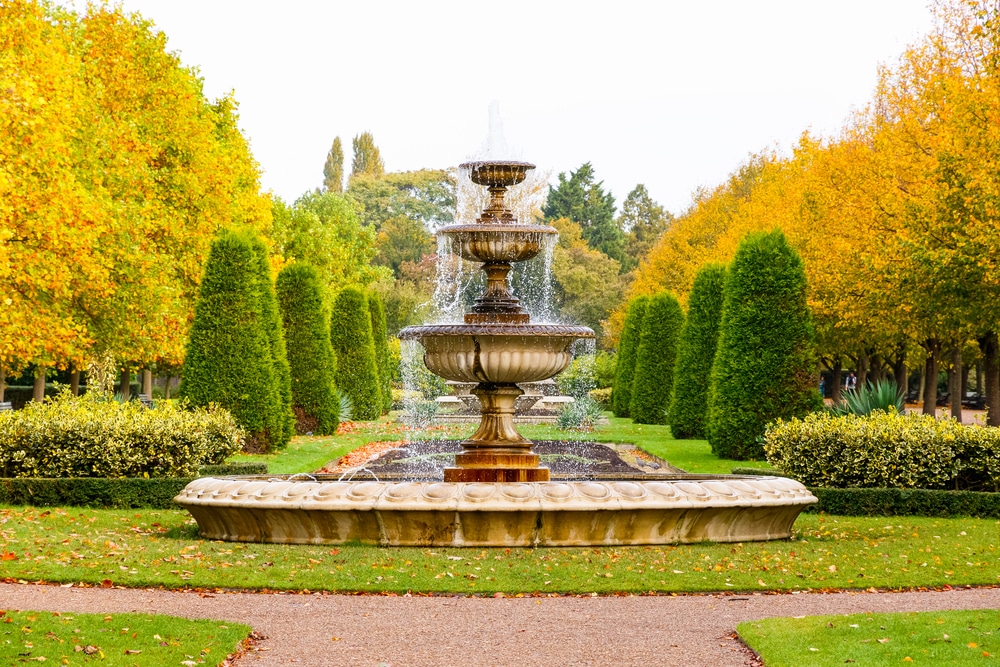 Source: I Wei Huang / shutterstock
Source: I Wei Huang / shutterstockArguably London’s finest park was laid out from the 1810s, initially for the Prince Regent, George IV, and named in his honour.
The men behind the design were John Nash and James and Decimus Burton, and Nash and Decimus Burton were also responsible for the terraces of palatial, stuccoed townhouses enclosing the park on the south, east and much of the west sides.
Tracing the north end meanwhile is the Regent’s Canal, and you can cross this to visit Primrose Hill for one of the great views of the London skyline.
Within the boundaries of Regent’s Park is the ever-popular London Zoo, while there’s much to love about the rest of the park.
Queen Mary’s Gardens has more than 12,000 roses, the Avenue Gardens are lined with stately flowerbeds, and you can hire a rowboat to glide around the boating lake among the waterfowl.
16. Natural History Museum
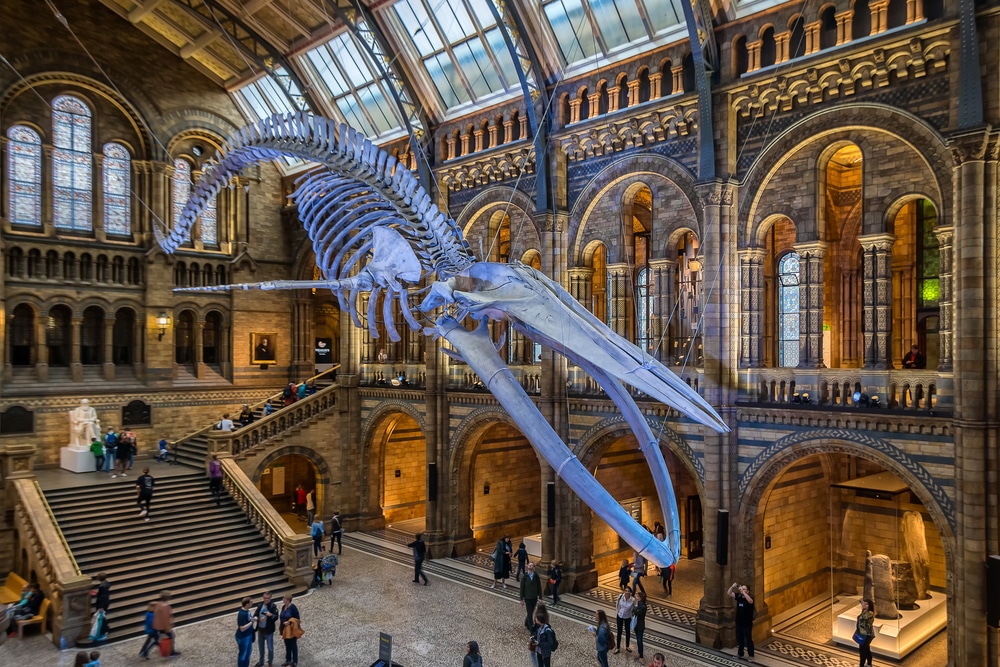 Source: elRoce / shutterstock
Source: elRoce / shutterstockPart of that incredible ensemble of museums in South Kensington, the Natural History Museum is a world leader for research in its field.
One of many special things about the attraction is the historical value of its 80 million+ specimens, a portion of which were gathered by world-changing naturalists like Charles Darwin, Alfred Russel Wallace and Hans Sloane.
The palace-like Romanesque Revival building (1881) is also extraordinary, clad with terracotta tiles to stand up to the sooty air of Victorian London.
If you’re intrigued by the historical figures who made the Natural History Museum what it is, you could sign up for a behind the scenes tour of the Spirit Collection at the institution’s Darwin Centre, which has 27 kilometres of shelves and 22 million animal specimens.
For youngsters the museum’s mounted dinosaur skeletons will kindle endless fascination. The long-standing star, Dippy, a 32-metre replica Diplodocus skeleton recently embarked on a nationwide tour and has been replaced in the vaulting Hintze Hall by a 19th-century Blue Whale skeleton.
Website: https://www.nhm.ac.uk/
17. Tower Bridge
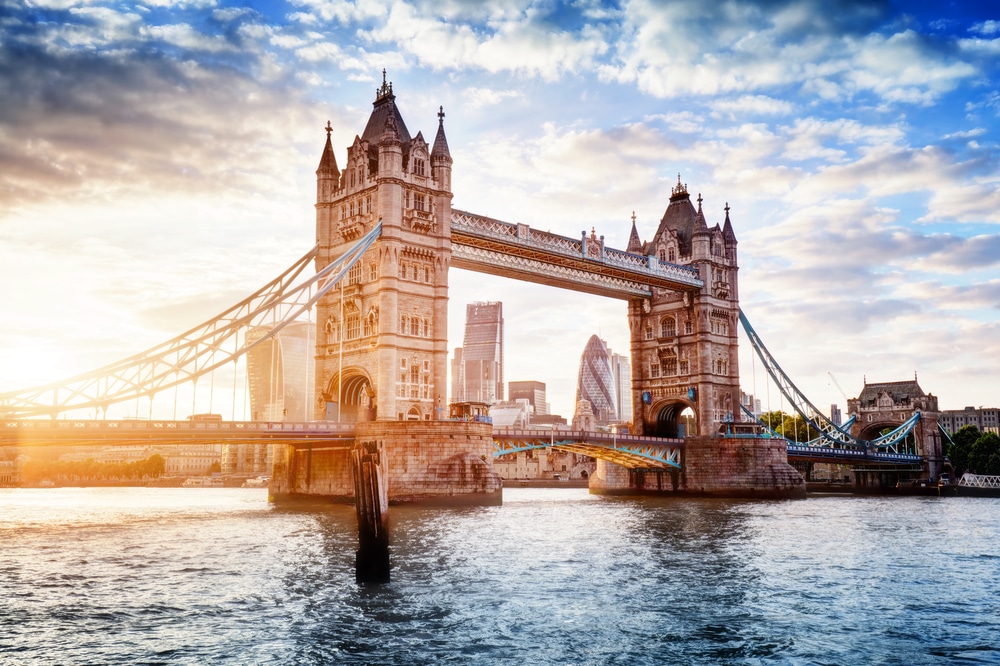 Source: PHOTOCREO Michal Bednarek / shutterstock
Source: PHOTOCREO Michal Bednarek / shutterstockThis stunning bascule and suspension bridge, constructed in a neo-Gothic style between 1886 and 1894, is yet another defining piece of the London skyline and is named after the Tower of London, which stands close by on the riverbank.
As well as being a sight to behold, Tower Bridge is a worthwhile attraction, letting you visit the Victorian engine rooms, still equipped with the original steam engines and hydraulic machinery.
On the tour you’ll find out about how a growing city in the late-19th century needed another river crossing and hear the story of the twin elevated walkways linking the two towers.
These were originally open to the public, but became a den of crime and remained closed from 1910 until the bridge opened as an attraction in the 1980s.
Now the walkways afford one of the great vistas of the city, 44 metres over the Thames at high tide, and over to Tower of London and the new towers of the City of London behind.
In 2014 two glass-floored sections were installed on the walkways, for a dizzying bird’s eye view of the bridge’s roadway framed by the murky Thames.
Website: https://www.towerbridge.org.uk/
18. Tate Britain
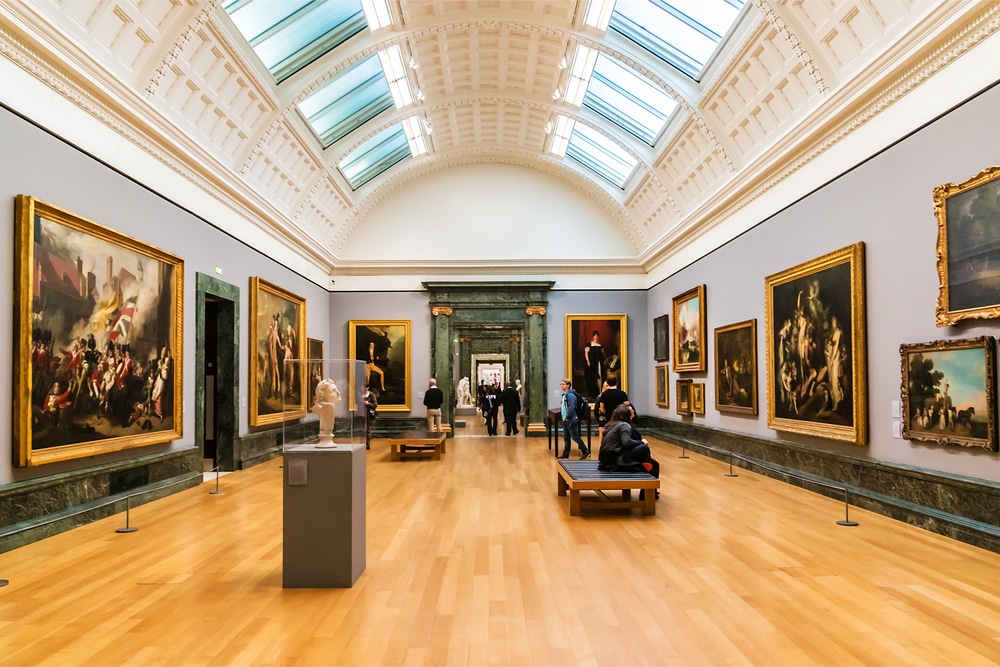 Source: Kiev.Victor / shutterstock
Source: Kiev.Victor / shutterstockThe nation’s collection of historic and contemporary British art awaits you at this museum facing the Thames on Millbank.
This is the oldest of all the Tate museums, in a grand Neoclassical building completed in 1897. The permanent collection is enormous, running from 1500 to the present day.
And although the display is rotated often you can expect to see pieces by J. M. W. Turner, Hogarth, Gainsborough, John Constable, William Blake, Henry Moore, Francis Bacon and Joshua Reynolds, to name a small handful.
The Tate Britain stages the exhibition for the Turner Prize, the UK’s most prestigious contemporary art award, and until recently was the setting for the prize ceremony every December.
Every year a British artist is also commissioned to create a new work to sit in the museum’s long Duveen Galleries, which first opened in 1937.
Website: https://www.tate.org.uk/visit/tate-britain
19. Museum of London
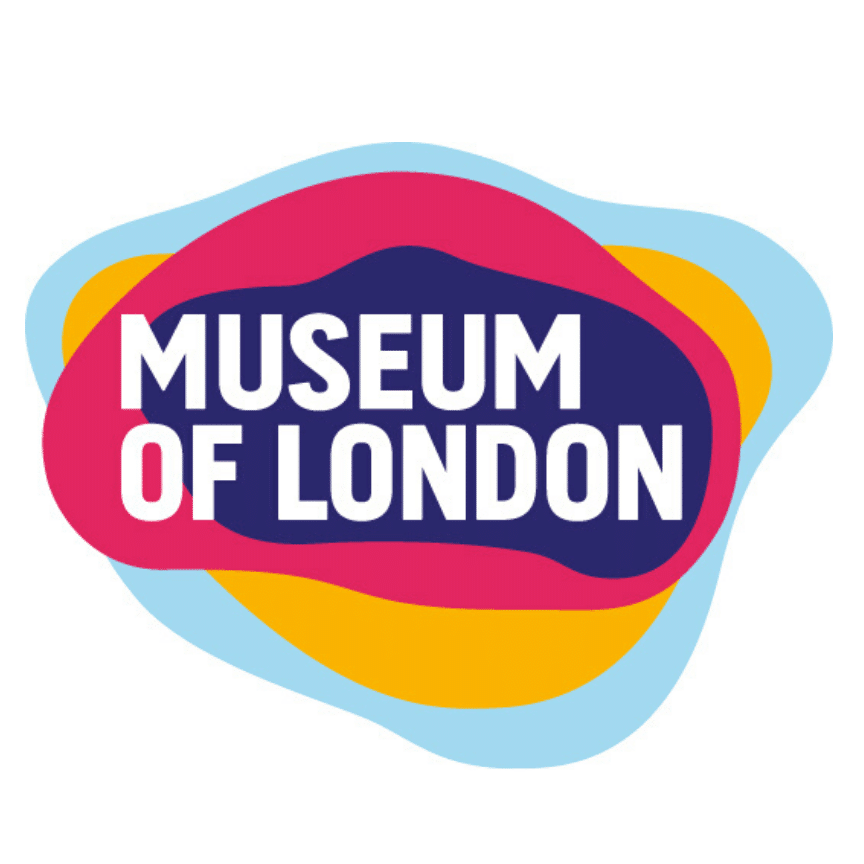 Source: facebook.com/museumoflondon
Source: facebook.com/museumoflondonSo we’ve seen that London’s past is enthralling, and new seams of history are unearthed all the time by construction and infrastructure projects like the Crossrail, the new east-west Elizabeth Line.
So this should put the Museum of London firmly in your sights. You’ll see prehistoric tools and tons of artefacts from Roman and Medieval London, as you learn about the Black Death and Great Fire of London, and get to grips with some of the darker aspects of being a global city in the Early Modern Age.
There’s costume, jewellery, architectural vestiges, weapons, ceramics, all sorts of ephemera and compelling larger exhibits like the preserved wooden walls of an 18th-century prison cell.
You can also negotiate a 19th-century street, while a second location at a converted sugar warehouse Docklands investigates London’s ties to the sugar and slave trades from the 1600s onwards.
The main site is at the Barbican, overlooking a piece of the Roman London Wall, but is due to move close by to Smithfield sometime in the mid-2020s.
Website: https://www.museumoflondon.org.uk/
20. The Shard
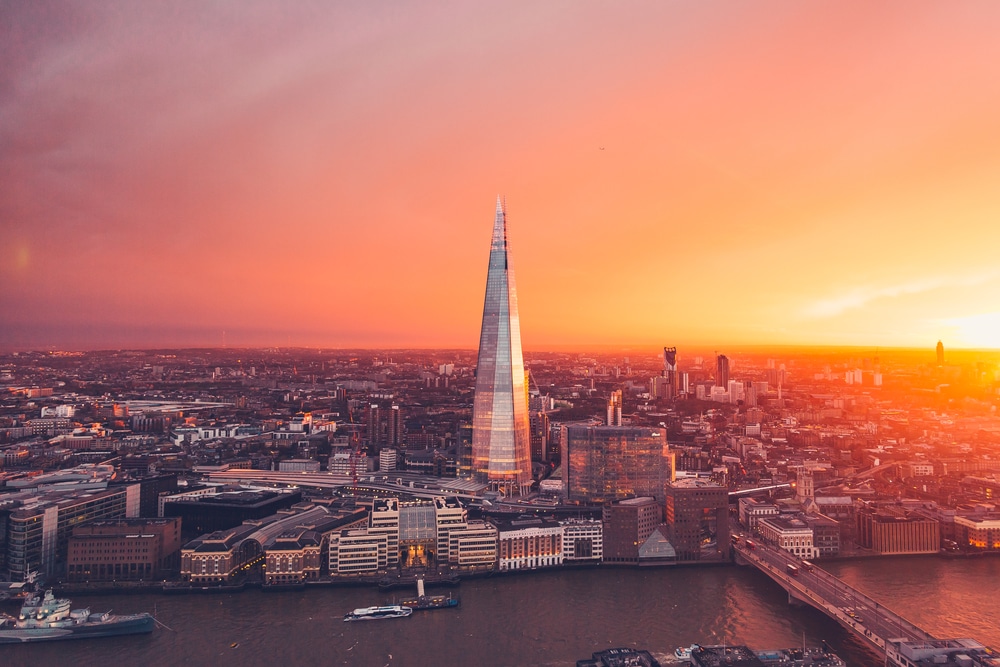 Source: Andy Shiels / shutterstock
Source: Andy Shiels / shutterstockIn the early-2010s London’s skyline was changed forever with the arrival of the tallest tower in the UK, which sprouted on the South Bank.
Designed by Renzo Piano, and in the pipeline for more than a decade before work began, the Shard opened officially in 2013 and stands at 309.6 metres, putting it comfortably in the top ten tallest buildings in Europe.
Being on the South Bank, The Shard’s Viewing Gallery presents the highest and one of the most satisfying views of the capital, extending across the Thames basin in all directions for 40+ miles when the weather is clear.
The indoor galleries are on Level 69, and you can feel the elements on the open-air Skydeck on Level 72. The Shard is a mixed-use tower, and as well as residential and office space, has a hotel and no fewer than six restaurants and bars, for afternoon tea, drinks or a meal paired with a gorgeous view of London.
Website: https://www.the-shard.com/
21. Kensington Palace
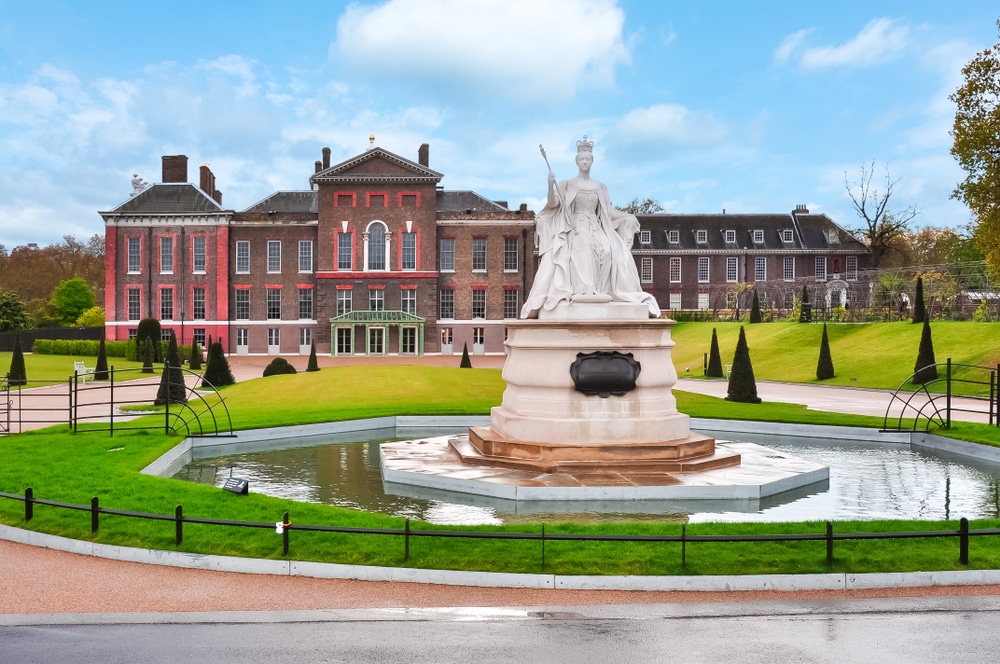 Source: Mistervlad / shutterstock
Source: Mistervlad / shutterstockIn the 1680s Sir Christopher Wren was again involved in turning the former Nottingham House, on the west side of Hyde Park, into a palace fit for royalty, namely William II and Mary II.
Queen Victoria was born at Kensington Palace in 1819, and the Baroque residence is the official London home of a number of royals, including the Duke and Duchess of Cambridge (William and Kate).
Kensington Palace is opened up to the public to give you a rare insight into a working royal household in the 21st century, and you’ll be able to tour historic areas like the King’s and Queen’s State Apartments, Queen Victoria’s re-imagined childhood rooms and the elegant formal gardens.
The palace is home to the Royal Ceremonial Dress Collection, with splendid court dress dating from the 1700s to the present day. The beautiful Orangery (1704), now holds temporary exhibitions and a cafe.
Website: https://www.hrp.org.uk/kensington-palace/
22. Wallace Collection
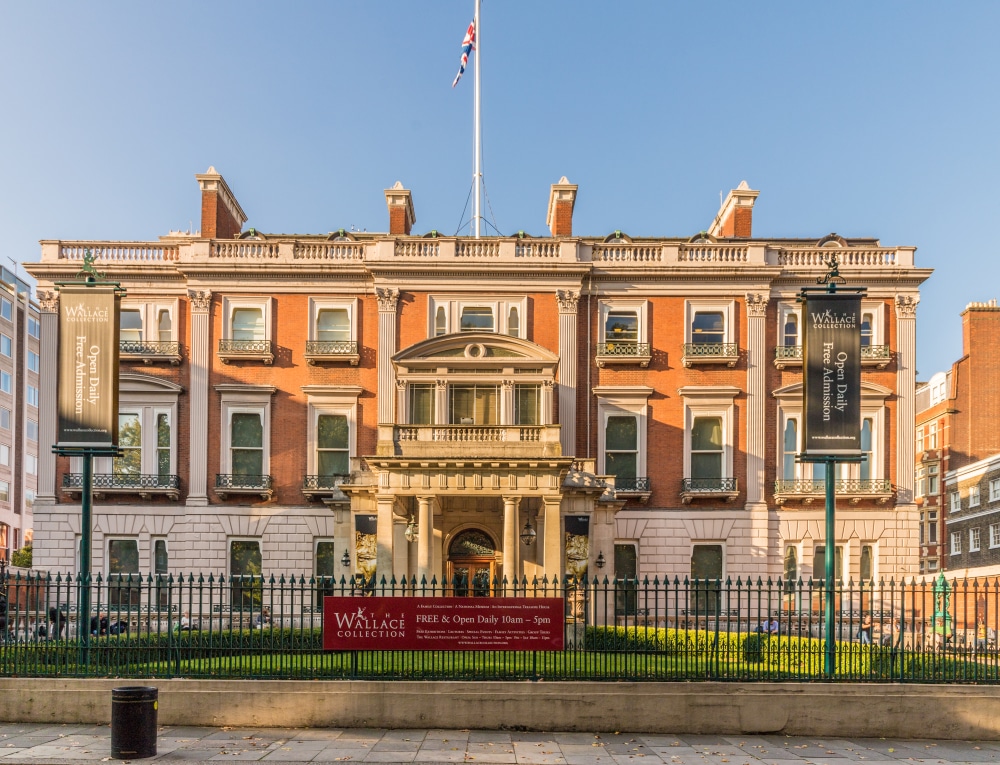 Source: Chrispictures / shutterstock
Source: Chrispictures / shutterstockAt an 18th-century townhouse near Bond Street station you’ll see the glorious decorative arts and fine arts amassed by five generations of one of Europe’s wealthiest families.
At the end of the 19th century the entire inventory was bequeathed to the nation. The Wallace Collection, much of which was gathered during the French revolutionary sales, shines for its array of 18th-century Ancien Régime decorative arts, hailed as possibly the finest in the world.
Making your way through the lavish rooms of Hertford House you’ll see exquisite Oriental and European weapons and armour, gold snuff boxes, Sèvres porcelain, Limoges enamels, Louis XIV furniture, glassware, majolica and much more.
And we haven’t even mentioned the fine art collection, which includes one of the world’s foremost assortments of miniatures, as well as Old Masters paintings by the likes of Rembrandt, Poussin, Titian, Rubens, van Dyck, Fragonard and Aelbert Cuyp.
Website: https://www.wallacecollection.org/
23. Borough Market
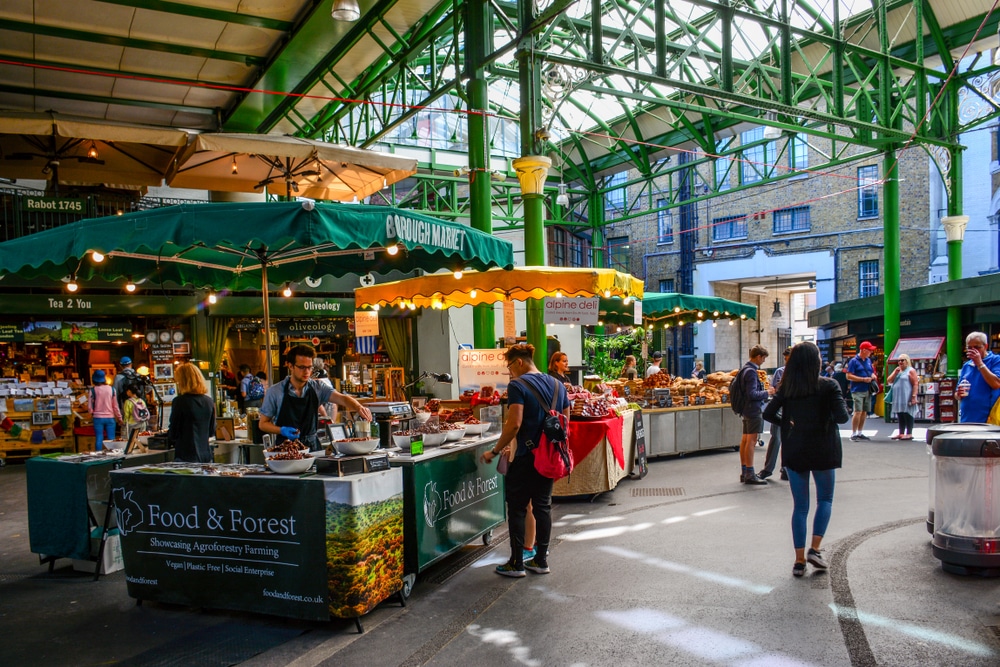 Source: andreyspb21 / shutterstock
Source: andreyspb21 / shutterstockEndlessly photo-worthy but also a food-lover’s dream, Borough Market is one of those spots that you’ve probably seen many times before without noticing.
When filmmakers need typical mid-19th century London street scenes, the market’s brickwork and steel and glass architecture often does the trick, and has appeared in Bridget Jones’s Diary (2001) and Harry Potter and the Prisoner of Azkaban (2003).
There has been trade at this location going back at least as far as the 1100s, and a brief walk of the area will bring you to the remnants of the 12th-century Winchester Palace and Southwark Cathedral, which has elements from the 13th century.
Whether you’re on the hunt for Mediterranean olives, traditional hand-raised pies, charcuterie, imported cheese, artisan chocolate and street food from across the globe, Borough Market’s retail stalls and shops are open Monday to Saturday.
Meanwhile there’s still a wholesale market here, trading from 02:00 to 08:00 on weekdays.
Website: https://boroughmarket.org.uk/
24. Hampton Court Palace
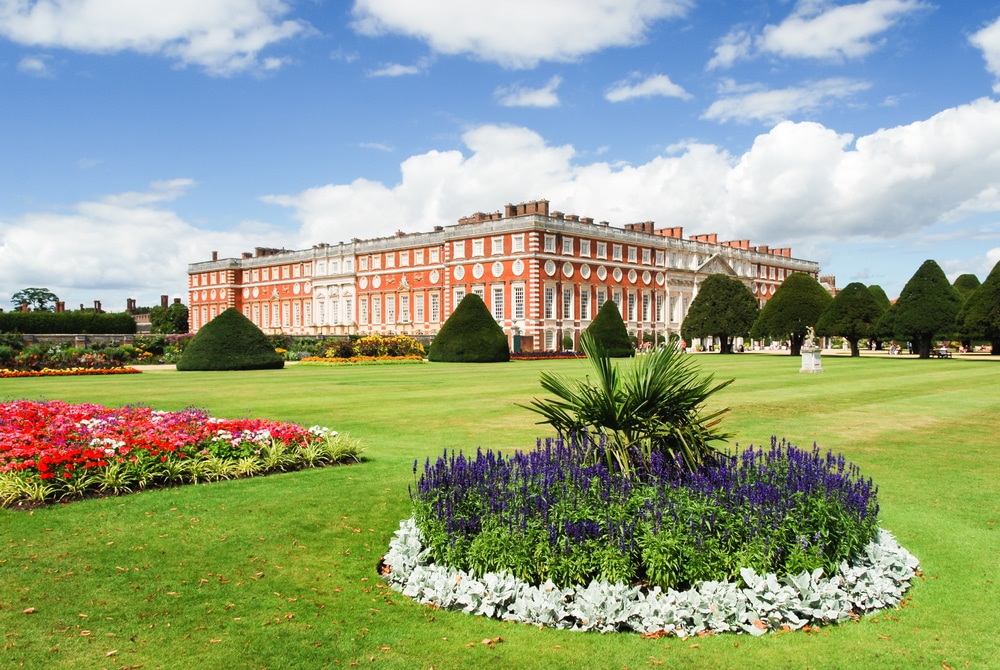 Source: Kirill Ts / shutterstock
Source: Kirill Ts / shutterstockAcquired from Cardinal Wolsey by Henry VIII in 1529, Hampton Court Palace was quickly enlarged and became a residence for a long line of monarchs through to George II in the mid-18th century.
The palace is on the Thames, just upstream from Kingston, and an easy train ride from London Waterloo station.
If you’re fascinated by Henry VIII, there’s much to explore, including Anne Boleyn’s Gate (1540), with its astronomical clock and Renaissance bas-reliefs, the Great Hall, boasting a carved hammer-beam roof and the Chapel, with its beautiful timber and plaster ceiling.
Henry was also responsible for the immense kitchens, capable of feeding his 1,000-strong court.
Under the joint monarchs William III and Mary II, the palace was reworked as an answer to Versailles. These Baroque additions, including the magnificent South Front, and the new State Apartments, were designed by Christopher Wren.
Allow plenty of time to see the grounds, where you’ll find Versailles-style parterres, gorgeous sunken gardens, the Banqueting House from 1700, the 16th-century Royal Tennis Court and a maze, planted for William III in 1690.
Website: https://www.hrp.org.uk/hampton-court-palace/
25. London Eye
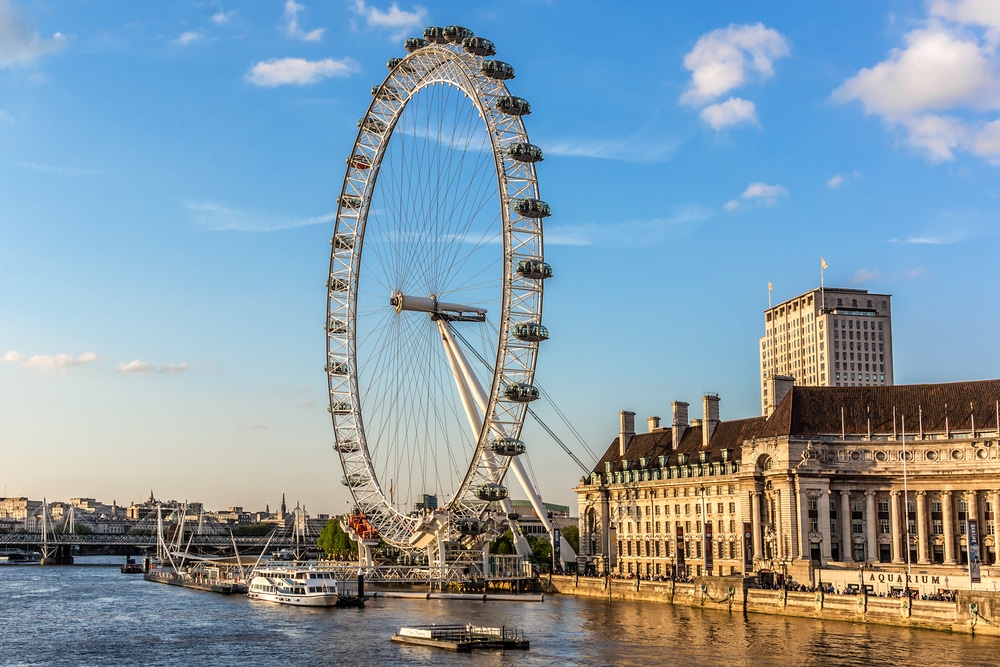 Source: Kiev.Victor / shutterstock
Source: Kiev.Victor / shutterstockNow, such a fixture of the London skyline and South Bank, it’s almost hard to believe that this giant Ferris wheel was only supposed to be a temporary attraction.
At the time of opening for the new Millennium, the London Eye was the tallest Ferris wheel in the world, at 135 metres, and until the arrival of The Shard, this was the highest viewing platform in the capital.
The wheel has 32 sealed capsules, each for a London Borough, and takes 30 minutes to make a full revolution, rarely needing to stop to take on passengers as the rate is so slow.
Being right over the Thames, there’s a fine view directly over Westminster Palace, and past the curve downriver to St Paul’s, The Shard and Canary Wharf beyond.
Website: https://www.londoneye.com/